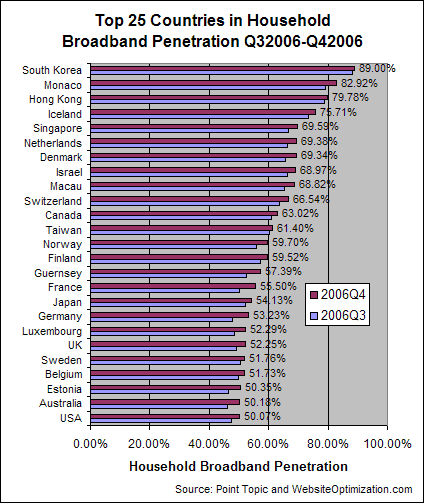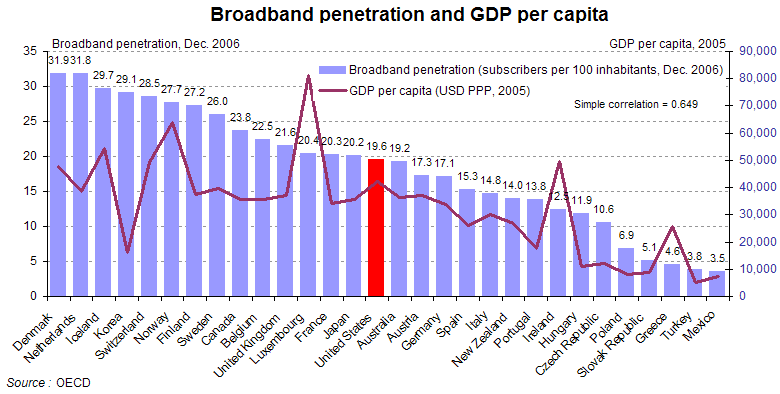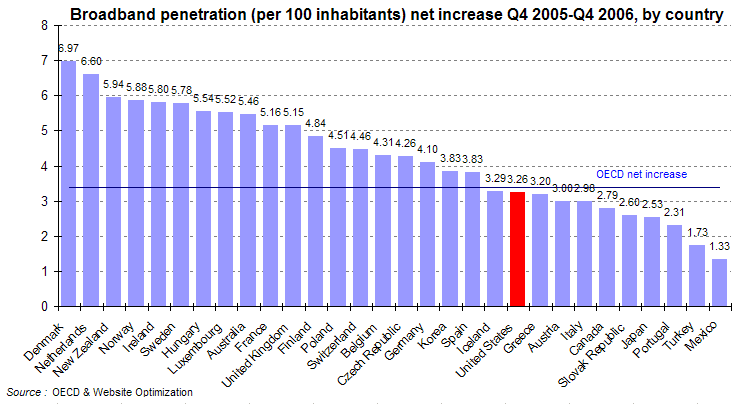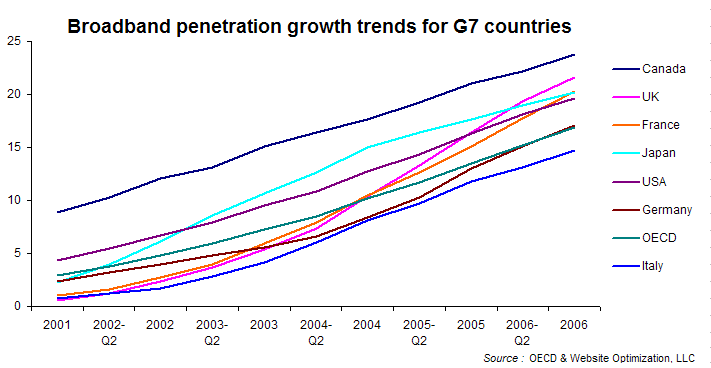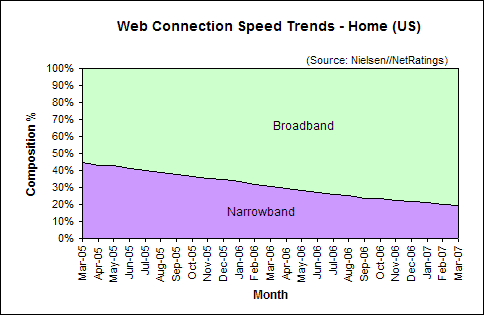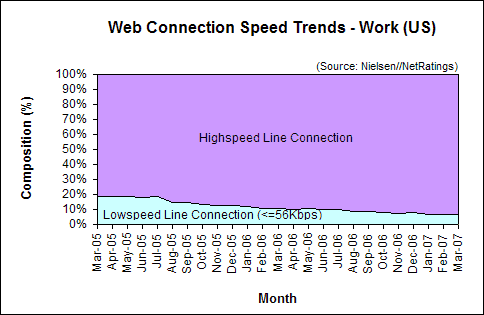The US fell from 23rd to 25th place in worldwide broadband penetration in the last half of 2006, according to a recent survey by Point Topic. OECD data confirms the slowdown, with the US falling to 15th in broadband penetration among OECD countries surveyed. US broadband penetration grew 0.65 percentage points to 80.81% among active Internet users in March.
US Falls to 25th in Broadband Penetration
Worldwide, the US fell from 23rd to 25th place in household broadband penetration during the last quarter of 2006. South Korea, Monaco, Hong Kong, Iceland, and Singapore lead all countries surveyed in household broadband penetration, according to Point Topic (see Figure 1).
Top 25 Countries in Household Broadband Penetration – Q32006 – Q42006
Figure 1: Top 25 Countries in Household Broadband Penetration
Source: Point Topic
US Falls to 15th among OECD Countries in Broadband Penetration
The US fell from 13th (revised) to 15th in broadband subscribers per 100 inhabitants (19.6) from Q2 2006 to Q4 2006 (see Figure 2). Japan, Luxembourg, and France passed the US in broadband penetration in the latter half of 2006. Denmark (31.9), the Netherlands (31.8), Iceland (29.7), Korea (29.1), and Switzerland (28.5) lead all OECD countries surveyed in broadband subscribers per 100 inhabitants for Q4 2006.
Figure 2: Broadband Penetration versus GDP per Capita per Country
Source: OECD
US Falls from 17th to 21st in Net Broadband Growth among OECD Countries
The US has fallen below the OECD average in net growth of broadband penetration per 100 inhabitants (see Figure 3). In our last OECD update the US was 17th in net growth among all countries surveyed (Q22005-Q22006). In the latest OECD survey the US has fallen to 21st in broadband penetration net growth to 3.26, below the OECD average of 3.39 for the first time.
Figure 3: Broadband Penetration Net Increase from Q4 2006 to Q4 2006 by Country
Source: OECD
Broadband Penetration Growth Trends of the G7
Among the G7, Canada maintains its commanding lead in broadband subscribers per 100 inhabitants at 23.8 (see Figure 4). The UK (21.6) and France (20.3) came in second and third with higher growth rates than the US and Canada. France passed Japan in the fourth quarter of 2006 to become third among G7 countries in broadband penetration per 100 inhabitants. The US currently ranks 5th at 19.6, ahead of Germany (17.1) and Italy (14.8).
Figure 4: OECD Broadband Growth Trends for G7 Countries
Source: OECD
Home Connectivity in the US
US broadband penetration grew to 80.81% among active Internet users in March 2007. Narrowband users connecting at 56Kbps or less now make up 19.19% of active Internet users, down 0.65 percentage points from 19.84% February 2007 (see Figure 5).
Web Connection Speed Trends – Home Users (US)
Figure 5: Web Connection Speed Trends – Home Users (US)
Source: Nielsen//NetRatings
Broadband Growth Trends in the US
In March 2007, broadband penetration in US homes grew 0.65 percentage points to 80.81%, up from 80.16% in February. This increase of 0.65 points is below the average increase in broadband of 0.88 points per month over the last six months (see Figure 6).
Broadband Adoption Growth Trend – Home Users (US)
Figure 6. Broadband Adoption Growth Trend – Home Users (US)
Extrapolated from Nielsen//NetRatings data
Work Connectivity
As of March 2007, 93.03% of US workers connected to the Internet with broadband, down 0.58 percentage points from the 93.61% share in February. At work 6.97% connect at 56Kbps or less (see Figure 7).
Web Connection Speed Trends – Work Users (US)
Figure 7: Web Connection Speed Trends – Work Users (US)
Source: Nielsen//NetRatings
Further Reading
- Broadband Internet Access Peaking – Wireless Connectivity To Drive Next Phase Of Global Internet Usage
- Future growth in ‘wired’ broadband access may slow with most users already using high-speed connections, according to Ipsos Insight’s “The Face of the Web” study. April 18, 2007.
- Nielsen//NetRatings
- Provided the US broadband penetration data for active Internet users for the Bandwidth Report.
- Organisation for Economic Co-operation and Development (OECD)
- “OECD Broadband Statistics to December 2006” report provided the worldwide broadband data for the Bandwidth Report.
- Point Topic
- The “World Broadband Statistics Q4 2006” survey provided the global broadband penetration data for this month’s bandwidth report. March 29, 2007.

